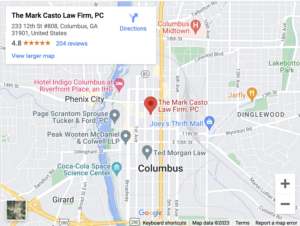
“Breach of duty” is a term that every law student learns early on. Formally, it is the second of the four elements of a negligence claim. You must prove breach of duty, along with three other legal elements, to win a negligence claim based on personal injury.
Context: The Four Elements of a Negligence Claim
To win a claim for negligence against an at-fault party, you must prove the following four elements:
- Duty: The defendant owed you a duty of care.
- Breach: The defendant breached their duty of care.
- Damages: You suffered bodily harm.
- Causation: The defendant’s breach of their duty of care was the foreseeable cause of the harm you suffered.
You must prove all of the foregoing elements, but you don’t have to prove them ‘beyond a reasonable doubt.’ You only have to prove a greater than 50% likelihood that each element is present.
Duties of Care: The Various Forms
Most personal injury cases involve the application of one of the following forms of the duty of care:
- Ordinary care: This is the duty of care that applies to almost every adult. Drive safely, and don’t engage in stupid or reckless activities, and more. Everyone except children and the mentally ill has a duty to act reasonably to avoid injuring others.
- The professional duty of care: A professional duty of care is an elevated duty of care that applies to people who are highly trained in a particular profession. A cardiologist, for example, must comply with a much higher duty of care than a ‘Good Samaritan’ who provides roadside assistance at the scene of a car accident. Likewise, a cardiologist must comply with a higher duty of care than a general practitioner in many contexts.
- Premises liability: The owner or operator of land or buildings owes a duty of care towards guests to either repair or warn of any dangerous conditions that they could discover through a reasonable inspection. In almost all cases, there is no duty to trespassers.
The majority of personal injury claims rely on establishing a duty of care (in addition to the other elements listed above).
How “Duty of Care” and “Breach of Duty” Work Together in Personal Injury Claims
Understanding the interplay between “duty of care” and “breach of duty” is critical. Their application varies widely depending on the circumstances. Following are some illustrative examples:
- Mark, a grocery store customer, slipped and fell on spilled liquid as he was walking down the aisle. Mark wins by proving that the grocery store owner had a duty to keep their premises safe for customers and that they violated this duty by failing to promptly clean up spilled liquids
- A driver runs a red light and causes a car accident. Their duty was to stop for the light, and they breached their duty by running it. Breach of duty might not be so easy to establish if the injured party had claimed that the defendant caused the accident by “tailgating.” After all, when it comes to following too closely, how close is too close?
- A dog owner allows their dog to roam freely, resulting in a dog bite claim from a neighbor.
In some cases, you might need an expert witness to prove breach of duty.
Ways of Proving Breach of Duty
Following is a listing of some of the ways that injury victims commonly prove breach of duty of care.
Appeal to Common Sense
Sometimes it all comes down to common sense. Tossing solid waste off a freeway overpass onto a highway, for example, is bound to get someone hurt. Sometimes simply proving what happened is enough to win your claim.
Res Ipsa Loquitur
Res ipsa loquitur (‘the thing speaks for itself’) is a way of proving breach of duty by establishing that an accident would not have occurred unless someone was negligent. It might apply if, for example, if:
- A hammer falls from the top of a building and hits a pedestrian;
- A lighter explodes in someone’s face; or
- An elevator drops and thereby injures someone.
Oftentimes, an injury victim will use res ipsa loquitur to provide the liability of someone responsible for maintaining equipment or mechanical systems. Res ipsa loquitur allows you to establish liability without specifying the exact nature of the breach of duty.
Negligence Per Se
‘Negligence per se’ is a shortcut to proving negligence by proving that the defendant broke a safety statute or regulation. In this case, the statute or regulation defines the duty of care, and the violation is what constitutes the breach of duty.
Expert Witness Testimony
In cases of professional negligence, the issue might be something technical, like “Should the doctor have ordered a C-section under those circumstances?” In this case, you might need the testimony of an expert witness to prove your claim.
A Columbus Personal Injury Lawyer Can Help You Sort It Out
Unless you are very familiar with Georgia negligence law, it can be challenging to establish a negligence claim to a court or an insurance company. Proving breach of duty is often the sticking point. Fear not, for a skilled Columbus personal injury can “unstick” it for you.
Contact an experienced Personal Injury Lawyer at Columbus, GA
We highly recommend reaching out to an experienced Columbus Personal Injury Attorney from Mark Casto Personal Injury Law Firm, we will provide you with guidance before taking any legal steps. Get in touch today with our personal injury law office, and don’t hesitate to give us a call at (706) 940-4030. We’re here to help!

